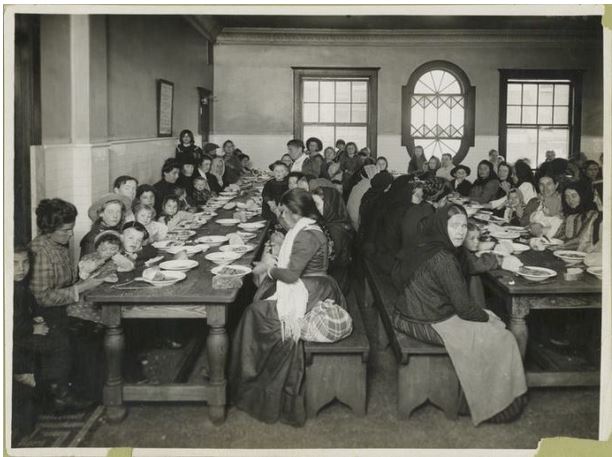 |
| SaveEllisIslandorg |
 |
| Ellis Island, right |
"Guided 90-minute tours will take you to select areas of the 750-bed Ellis Island Hospital. Visit the Laundry Building, with much of its original equipment still in place, where over 3000 pieces of laundry were washed and sanitized daily, infectious and contagious disease wards, kitchen, staff housing, autopsy room and more."....
"Ellis Island Immigration Museum is part of the Statue of Liberty National Monument and is under the care of the National Park Service. For many, Ellis Island is one of the most meaningful historic sites in New York. Visitors can easily spend hours here learning about America’s immigration history and the varied roles the island has played since the nation’s early years. The Immigration Museum tells the stories of why so many people chose to come to America and what became of them after they arrived. When visiting the monument, be sure to stop at the Information desk in the Immigration Museum to visit with the Save Ellis Island volunteer staff." Two images above from Save Ellis Island
"It is estimated that 40% of all current U.S citizens can trace at least one ancestor to Ellis Island....The ‘Passage of Immigrant Quota Act’ of 1921 ended the era of mass immigration to New York....During the peak period of Ellis Islands operations between 1900 and 1914, 5,000 to 10,000 passed through the immigration station each day."...
 |
| SaveEllisIslandorg |
"Visiting Ellis Island"
"Today the Ellis Island Immigration Museum is part of the Statue of Liberty National Monument and is under the care of the National Park Service."
"Ellis Island Facts"
"Did you know?"
"Some say that Ellis Island was the ‘gateway to the American dream’ but what we do know for a fact is that it was the gateway to America for 60 years. With a rich history, read on for some interesting and surprising Ellis Island facts…
An Island with Purpose
Ellis Island was opened in 1892 as a Federal Immigration station, a purpose it served for 60 years. Millions of immigrants passed through the station many from eastern and southern Europe and many were escaping poverty and conflict.
A Journey Before the Journey
Typically starting on horseback or train from cities and towns across Europe, many travelers had a long journey just to get to the seaport. They then boarded ships that were crowded, filled with a diverse group of up to 3,000 passengers all from different cultures and religions. and trekked across the Atlantic for 2 weeks
Conditions Onboard the Steamships
Passengers were dispersed between first class, second class and steerage, according to wealth of each passenger. The contrast between first and second classes meant that those with greater wealth enjoyed staterooms and cabin whilst steerage was just an open space at the bottom of the boat.
Tracing Ancestry
It is estimated that 40% of all current U.S citizens can trace at least one ancestor to Ellis Island....
Humble Beginnings of a Future NYC Mayor
Working as an interpreter for the Immigration Service at Ellis Island from 1907 to 1910, Fiorello La Guardia later became the Mayor of New York City. A New York native, La Guardia’s parents were immigrants of Italian and Jewish heritage.
Eating at Ellis Island
 |
| SaveEllisIslandFacts |
Free meals were served on the island and a typical meal could include beef stew, potatoes, bread, herrings, baked beans and stewed prunes. There were also independent concessions that sold packaged food to be bought as people waited or to take with them when they left the island....
Peak Time of Arrivals
During the peak period of Ellis Islands operations between 1900 and 1914, 5,000 to 10,000 passed through the immigration station each day. The ‘Passage of Immigrant Quota Act’ of 1921 ended the era of mass immigration to New York."
............

No comments:
Post a Comment